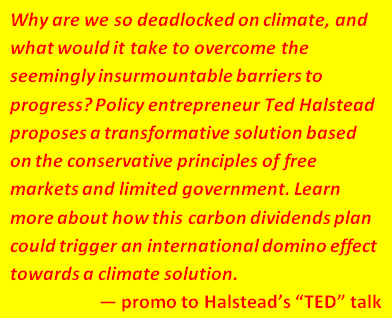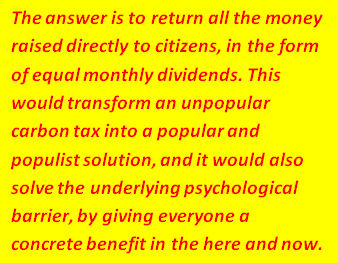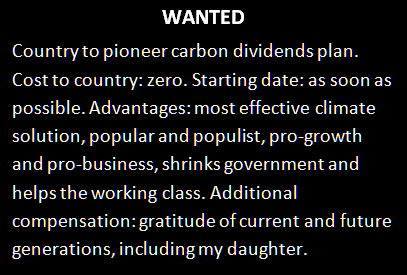Perhaps no one in the U.S. has done more lately to drive public and political opinion toward carbon taxes than Ted Halstead and his Climate Leadership Council. The council’s Conservative Case For Carbon Dividends is the first Republican-based carbon tax proposal to insist not only on starting high (at $40 per ton of CO2) but also “dividend-ing” the revenues to U.S. families rather than using them to pay for corporate tax cuts (as favored by the political right) or investing them in transit, renewables and other elements of “the just transition” (as favored by much of the left).
This income-progressive but limited-government path, which Halstead and the council astutely brand as Republican, has generated a broad swath of editorial support, not just on the two coasts but also in conservative, carbon-heavy Texas. Partly that’s because the proposal would downsize or outright rescind direct federal regulation of carbon emissions, which the council argues would be mooted by the market pull of a robust (and rising) carbon tax. It’s also because Halstead has the verbal facility and personal magnetism to make his points appealing and convincing.
Not just his first name, then, makes Halstead an ideal “TED” talker, as you can see in the 11-minute talk (13, counting Q/A with moderator Chris Anderson) he taped in April and released yesterday.
Below, we present an abridged version of Ted’s talk. The full transcript can be viewed along with the video presentation.
We need a killer app to climate policy. In the technology world, a killer app is an application so transformative that it creates its own market, like Uber. In the climate world, a killer app is a new solution so promising that it can break through the seemingly insurmountable barriers to progress.
These include the psychological barrier. Climate advocates have long been encouraging their fellow citizens to make short-term sacrifices now for benefits that accrue to other people in other countries 30 or 40 years in the future. It just doesn’t fly because it runs contrary to basic human nature.
 Next is the geopolitical barrier. Under the current rules of global trade, countries have a strong incentive to free-ride off the emissions reductions of other nations, instead of strengthening their own programs.
Next is the geopolitical barrier. Under the current rules of global trade, countries have a strong incentive to free-ride off the emissions reductions of other nations, instead of strengthening their own programs.
Finally, we have the partisan barrier. Even the most committed countries are nowhere near reducing emissions at the required scale and speed. And the partisan climate divide is far more acute here in the United States. We are fundamentally stuck, and that is why we need a killer app of climate policy to break through each of these barriers.
I’m convinced that the road to climate progress in the United States runs through the Republican Party and the business community. So in launching the Climate Leadership Council, I started by reaching out to a who’s who of Republican elder statesmen and business leaders, including James Baker and George Schultz, the two most respected Republican elder statesmen in America; Martin Feldstein and Greg Mankiw, the two most respected conservative economists in the country; and Henry Paulson and Rob Walton, two of the most successful and admired business leaders. Together, we co-authored “The Conservative Case For Carbon Dividends.” This represents the first time that Republican leaders put forth a concrete market-based climate solution.
Our carbon dividends solution is based on four pillars.
1. The first is a gradually rising carbon tax. Although capitalism is a wonderful system, like many operating systems, it’s prone to bugs, which, in this case, are called “market failures.” By far the largest is that market prices fail to take social and environmental costs into account. That means every market transaction is based on incorrect information. This fundamental bug of capitalism, more than any other single factor, is to blame for our climate predicament.
In theory, this should be an easy problem to fix. Economists agree that the best solution is to put a price on the carbon content of fossil fuels, otherwise known as a carbon tax. This would discourage carbon emissions in every single economic transaction, every day of the year. However, a carbon tax by itself has proven to be unpopular and a political dead end. The answer is to return all the money raised directly to citizens, in the form of equal monthly dividends. This would transform an unpopular carbon tax into a popular and populist solution, and it would also solve the underlying psychological barrier that we discussed, by giving everyone a concrete benefit in the here and now.
 According to the US Treasury Department, the bottom 70 percent of Americans would receive more in dividends than they would pay in increased energy prices. That means 223 million Americans would win economically from solving climate change. And that is revolutionary, and could fundamentally alter climate politics.
According to the US Treasury Department, the bottom 70 percent of Americans would receive more in dividends than they would pay in increased energy prices. That means 223 million Americans would win economically from solving climate change. And that is revolutionary, and could fundamentally alter climate politics.
2. But there’s another revolutionary element here. The amount of the dividend would grow as the carbon tax rate increases. The more we protect our climate, the more our citizens benefit. This creates a positive feedback loop, which is crucial, because the only way we will reach our long-term emission-reduction goals is if the carbon tax rate goes up every year.
3. The third pillar of our program is eliminating regulations that are no longer needed once a carbon dividends plan is enacted. This is a key selling point to Republicans and business leaders. So why should we trade climate regulations for a price on carbon? Our plan would achieve nearly twice the emissions reductions of all Obama-era climate regulations combined, and nearly three times the new baseline after President Trump repeals all of those regulations. Our plan by itself would meet the high end of America’s commitment under the Paris Climate Agreement, and the emissions reductions would continue over time. We would end up with less regulation and far less pollution at the same time, while helping working-class Americans get ahead. Doesn’t that sound like something we could all support?
4. The fourth and final pillar of our program is a new climate domino effect, based on border carbon adjustments. Now that may sound complicated, but it, too, is revolutionary, because it provides us a whole new strategy to reach a global price on carbon, which is ultimately what we need. Once one major country or region adopts carbon dividends with border carbon adjustments, other countries are compelled to follow suit [to prevent paying border adjustments to countries with carbon taxes]. One by one the dominoes fall. And this domino effect could start anywhere.
 Let’s take China as an example. China is committed to reducing greenhouse gas emissions, but what its leaders care even more about is transitioning their economy to consumer-led economic development. Well, nothing could do more to hasten that transition than giving every Chinese citizen a monthly dividend. In fact, this is the only policy solution that would enable China to meet its environmental and economic goals at the same time.
Let’s take China as an example. China is committed to reducing greenhouse gas emissions, but what its leaders care even more about is transitioning their economy to consumer-led economic development. Well, nothing could do more to hasten that transition than giving every Chinese citizen a monthly dividend. In fact, this is the only policy solution that would enable China to meet its environmental and economic goals at the same time.
That’s why this is the killer app of climate policy, because it would enable us to overcome each of the barriers we discussed earlier: the psychological barrier, the partisan barrier, and, as we’ve just seen, the geopolitical barrier. All we need is a country to lead the way. And one method of finding what you’re looking for is to take out an ad. So let’s read this (shown at left) one together.

jason G. Brent says
Nothing will prevent the near term extinction of humanity except a rapid reduction in population starting today. That reduction must reduce the human population to below 500 million. Therefore, any carbon tax is a very bad joke on humanity.
Gjalt Huppes says
Reply to Jason Brent: Reducing population by 90% on short notice would require a fast start in the killing. Will you be the first to start, with yourself, or your neighbour? Cambodia had a try on this but failed utterly.
David Collins says
I think of one unaddressed problem with a carbon tax with all the take returned to the people on a count-the-noses basis. It’s like the dog chasing a car down the street: what’s the dog gonna do when it catches the car?
Assume a carbon tax is implemented, and the take is returned to us grateful proles. But the rising tax rate has its desired effect and in time CO₂ emissions fall to zip. Stored carbon-free energy abounds, for transportation, residential heating, cooking, everything the proles need energy for. Overall, manufacturing, distribution, national defense et alia all operate effectively and satisfactorily with no CO₂ (or other greenhouse contributing) emissions. Hence, no carbon tax dividends for us proles, but we remember the good old days when we enjoyed incomes supplemented by those dividends. We proles get upset.
I see the carbon tax with border adjustments (“decarbonization in one country), and its disbursement to us proles as the imprescindible component of decarbonizing the economy worldwide. But it is not a complete solution. The invisible hand of lazy færie economics needs to be guided, or angry proles will be horribly disruptive.
How should the regulatory hand guide the invisible hand?
Charles Komanoff says
The eventual decline in carbon dividends is less of a problem than you suggest. That’s because the carbon price that determines the dividend amount (along with total carbon emissions) will be rising as emissions are falling. Thus, the dividend decline will be gradual rather than abrupt.
Lorena Valdez says
Will someone kindly explain to me how this would truly work? If consumers are receiving dividends and know they will, and these dividends steadily rise each year…where is the incentive to use less fossil fuels? At the pump?
Where are the investments in renewable energy in this plan? Does that not factor into the pockets of conservatives sleeping with the big fossil fuel industries?
I would appreciate a little clarification, thank you!
Charles Komanoff says
The incentive to use less fossil fuels is “expressed” through the carbon fee that, by design, makes it more expensive to use them (whether directly as gasoline, or indirectly as electricity consumers or suppliers). The dividend checks you and I and every U.S. resident will receive won’t undermine the incentive, since those checks are based on everyone’s collective fossil fuel consumption rather than our individual usage.
Say, hypothetically, I’m an average American, responsible, directly and indirectly, for around 17 tons of CO2 a year; and say the carbon tax, in its first year, is $10 per ton of CO2. My tax — which I’ll pay as more expensive gasoline, more expensive products that required fossil fuels to make and ship, costlier electricity (unless it was zero-carbon), etc. — will be $170 in that year (17 tons x $10 per ton). That will also be my dividend, assuming everyone’s fossil fuel usage is unchanged, since 325 million residents x 17 tons per resident x $10 per ton divided by 325 million dividend recipients equals $170 (see how the 325 millions “cancel out” arithmetically?).
Now — and here’s the point — I’ll get that $170 check regardless of whether I eliminate my fossil fuel use, or leave it unchanged, or perversely double it. In the first case I’ll end up with a net gain of $170 (since my dividend = $170 while my tax = $0). In the second case I’ll end up even ($170 dividend less $170 tax). In the last case I’ll be $170 behind ($170 dividend minus $340 tax). While these cases are (intentionally) extreme, they illustrate that the carbon fee will “incentivize” me to cut down on usage in order to be at breakeven or better.
(A better illustration might be to assume that total national usage drops by, say, 6 percent, so the dividends end up being $160. This might make more clear that I have an incentive to economize on fossil fuels so I don’t end up “underwater” monetarily.)
Let me know if this clarifies.
As to your question, Where are the investments in renewable energy? They’re in the same place with the carbon fee as without, except slightly better, since the increased prices of fossil fuels due to the fee will cause even more renewable projects to “pencil out in the black,” i.e., be profitable.
Thanks for writing. You’re hardly the first person to ask these questions. We’re going to add them to our Dividends page.